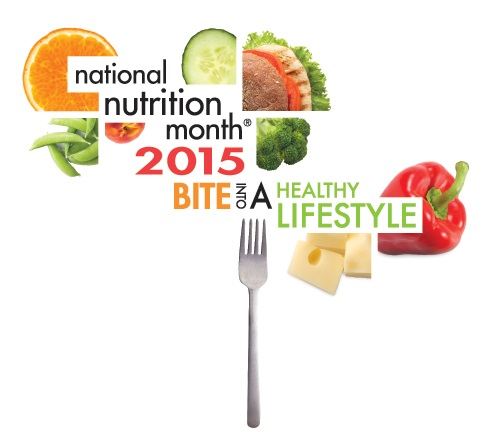
If you’ve been chewing on the thought of improving your food choices and starting your journey toward a healthy lifestyle, there is no better time to begin than now. March is National Nutrition Month—an annual campaign organized by the American Academy of Nutrition and Dietetics aimed at educating and empowering Americans into healthier lifestyles. The theme for this year’s nutrition month is “Bite into a Healthy Lifestyle” which encourages everyone to make informed food choices, keep portion sizes in check and engage in fitness routines that are meaningful and enjoyable.
The word “bite” means to take a small piece of a bigger portion, chew it well, savor the flavor and then swallow before taking the next bite. This year’s theme can be interpreted to mean that healthy living is not about making grand changes all at once. Rather, it is a steady continual process that allows for gradual improvement in many areas of your life. The focus is on taking one “bite” at a time into new territory—savoring a small change and allowing it to become a new habit before taking the next “bite.” The small changes you make each day or week will add up to big changes over time.
To help inspire you to make more meaningful food and fitness choices, the word “BITE” can be used as an acronym that encompasses key components of a healthy lifestyle. As you begin to make each of these a working part of your life, you will find that healthful eating and physical activity are realistic and enjoyable.
B – Balance. At its most profound level, health is not is not just the absence of pain, stress, or disease, but also an abundance of vitality, passion and purpose. It is the daily experience of wholeness and balance—a state of being fully alive. Getting to this state can begin with conscious, mindful food choices. Once your body is nourished properly, you will have more energy and motivation to exercise, and you will find that your are more willing to make other positive changes in your life.
It is best to begin by adding more healthful foods into your meals, and gradually eliminate the sugar and processed foods. Balance your plate by filling it with plenty of vegetables and fruits, and lesser amounts of other plant foods such as whole grains, beans, nuts, seeds and healthy fats. If you eat animal foods such as, eggs, dairy, meats, fish and poultry, save a small space, about one fourth of your plate, for smaller portions of these foods. Make it a practice to have at least three different colors on your plate at each meal. Balancing your meals this way is essential not only for ensuring that you get the proper amount of nutrients your body needs, but also the eye appeal and the emotional comfort that satisfies all of your senses.
The colors in plant foods represent certain vitamins and phytonutrients (beneficial compounds, including antioxidants, that give these foods their disease fighting properties.) Eating an abundance of colorful foods can help protect against chronic diseases such as high cholesterol, heart disease, diabetes, obesity, high blood pressure, cancer and Alzheimer’s.
To help you put together a nutrient-rich balanced plate, here’s a guide to the colors in foods and how they contribute to a healthy lifestyle:
RED plant foods contain vitamins A and C, and the phytonutrient lycopene, a powerful cancer fighter. Examples are tomatoes, red peppers, watermelon, cherries, raspberries, pink guavas, red grapes, strawberries, red apples and red grapefruit.
YELLOW/ORANGE plant foods also contain vitamins A and C, and the phytonutrient beta-carotene, known to prevent heart disease as well as lung and colon cancers. Examples are apricots, cantaloupes, carrots, mangoes, papayas, peaches, persimmons, yellow squash, pumpkins, winter squashes and sweet potatoes.
BLUE/PURPLE plant foods also contain vitamins A and C, and a class of phytonutrients called anthocyanins, which have anti-aging and anti-cancer effects and help to promote circulatory function. Examples are blackberries, black currants, blueberries, grapes, raisins, plums, red cabbages, eggplant, purple potatoes and red onions.
BROWN plant foods contain B vitamins, vitamin E, and classes of phytonutrients called isoflavones, lignans, and phytosterols which prevent the oxidation of cholesterol, thus reducing the risk of cardiovascular disease. Examples are whole grains, beans, lentils, nuts, seeds, and mushrooms.
GREEN plant foods contain all the vitamins (except vitamin D), and the phytonutrient compounds known as chlorophyll, lutein, isoflavones, and glucosolinates which are highly detoxifying, and are known cancer fighters. Green foods also help aid weight loss as they regulate blood sugar levels and stop cravings for sugary, fatty foods. Examples are leafy vegetables like lettuces, spinach, kale, collards, cabbage, bok choy, Swiss chard, asparagus, avocadoes, broccoli, Brussels sprouts, chives, cucumbers, green peas, green beans, kiwis, leeks, zucchini, wheat grass, and the algae superfoods known as spirulina and chlorella.
WHITE plant foods contain vitamins A and C, and the phytonutrients allicin and quercitin. known cancer-fighting antioxidants, and are natural anti-inflammatory and anti-bacterial agents. Examples are garlic, leeks, onions, shallots, bananas, cauliflower, mushrooms, and potatoes.
I – Invest. A healthy lifestyle is an investment you make in yourself every day. You have to make yourself a priority, spending time and money to make sure that you set yourself up for success. Invest in healthy food, good cookware, time-saving kitchen appliances like a crockpot, food processor or powerful blender to make food prep fast and easy. Take cooking classes or watch videos that will help you learn new techniques and recipes. Invest in a good pair of shoes for taking walks or working out. Invest in the right number of hours of sleep for your body—most people need 7 to 8 hours a night. Finally, invest is good clean water, such as reverse osmosis, spring water or alkaline water, and drink at least eight glass a day.
At first these may seem like big investments, but taking them one bite at a time makes it doable. Hiring a nutritionist or a personal trainer can help you set goals and keep you accountable. Start with the most achievable investments first, and make a list of the others you want to work toward. The time and money you spend on your health today will be time well spent to save yourself from having to spend more time and money later on doctor visits and medications. Like any good investment, it’s a gift you give to yourself that gives back to you in return.
T – Transform. Once you’ve learned to balance your plate, the next “bite” is to take your food quality to the next level, to increase nutrients and reduce your exposure to harmful toxins that are found in produce sprayed with chemicals and foods from animals that have been fed an unnatural diet. Opt for organically grown produce whenever possible. A July 2014 study showed that the nutrient content in organically grown fruits, vegetables and whole grains contained 17 percent more antioxidants than their conventionally grown counterparts, and for some antioxidants the difference was as high as 69 percent more. The main reason to opt for organic is to reduce your exposure to pesticides and herbicides, of which many are linked to obesity, cancer and diseases of the immune system, even in small doses.
When it comes to animal foods, choosing hormone-free, antibiotic-free and organic options as often as possible can also reduce your risk of chronic exposure to harmful toxins. If you consume dairy and eggs, start with those first by switching to organic varieties. Reduce your consumption of meats and poultry, and gradually transition to organic when possible.
E – Enjoy. With a personal commitment to live your best life, you must continue to find ways to make being healthy fun and enjoyable. Let’s face it, if you don’t enjoy it, you won’t do it. When it comes to making healthy food choices, start with adding more of the vegetables, fruits and other plant foods that you like, before venturing into trying new ones that might be unappealing to you. Make it a practice to try just one new fruit, vegetable or whole grain each week to see if you like it. Make a list of the ones you like, and make sure to always have a supply of those on hand for your meals and snacks.
The same concept applies to fitness—you should start with an activity that you enjoy. Do you like to dance, swim, ride a bicycle, roller skate, walk or bounce on a trampoline? Do you like team sports or group classes? What was your favorite form of activity when you were a kid? Start slowly by engaging in activities that make you feel good, not like a chore.
With both food and fitness choices, start with what you know and like, and don’t “bite” off more than you can chew.
Wholesome satisfying foods and a meaningful fitness routine are the best life and health insurance available. Let them be your foundation for a naturally healthy lifestyle that nourishes you in many ways.
Celebrate National Nutrition Month this March by making small gradual changes to improve your health, one bite at a time, one day at a time.

